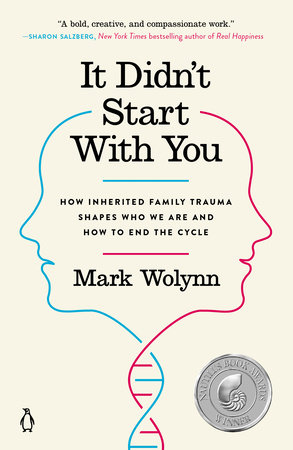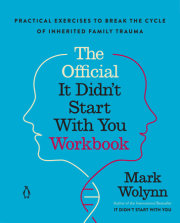Chapter 1
Traumas Lost and Found
The past is never dead. It's not even past.
-William Faulkner, Requiem for a Nun
A well-documented feature of trauma, one familiar to many, is our inability to articulate what happens to us. Not only do we lose our words, but something happens with our memory as well. During a traumatic incident, our thought processes can become scattered and disorganized in such a way that we no longer recognize the memories as belonging to the original event. Instead, fragments of memory, dispersed as images, body sensations, and words, are stored in our unconscious and can become activated later by anything even remotely reminiscent of the original experience. Once they are triggered, it is as if an invisible rewind button has been pressed, causing us to reenact aspects of the original trauma in our day-to-day lives. Unconsciously, we could find ourselves reacting to certain people, events, or situations in old, familiar ways that echo the past.
Sigmund Freud identified this pattern more than one hundred years ago. Traumatic reenactment, or "repetition compulsion," as Freud called it, is an attempt of the unconscious to replay what's unresolved, so we can "get it right." This unconscious drive to relive past events could be one of the mechanisms at work when families repeat unresolved traumas in future generations.
Freud's contemporary Carl Jung also believed that what remains unconscious does not dissolve but, rather, resurfaces in our lives as fate or fortune. Whatever is not conscious, he said, will be experienced as fate. In other words, we're likely to keep repeating our unconscious patterns until we bring them into the light of awareness. Both Jung and Freud noted that whatever is too difficult to process does not fade away on its own but, rather, is stored in our unconscious.
Freud and Jung each observed how fragments of previously blocked, suppressed, or repressed life experience would show up in the words, gestures, and behaviors of their patients. For decades to follow, therapists would see such clues as slips of the tongue, accident patterns, or dream images as messengers shining a light into the unspeakable and unthinkable regions of their clients' lives.
Recent advances in imaging technology have allowed researchers to unravel the brain and bodily functions that "misfire" or break down during overwhelming episodes. Bessel van der Kolk is a Dutch psychiatrist known for his research on posttraumatic stress. He explains that during a trauma, the speech center shuts down, as does the medial prefrontal cortex, the part of the brain responsible for experiencing the present moment. He describes the speechless terror of trauma as the experience of being at a loss for words, a common occurrence when brain pathways of remembering are hindered during periods of threat or danger. "When people relive their traumatic experiences," he says, "the frontal lobes become impaired and, as [a] result, they have trouble thinking and speaking. They no longer are capable of communicating to either themselves or to others precisely what's going on."
Still, all is not silent: words, images, and impulses that fragment following a traumatic event reemerge to form a secret language of our suffering we carry with us. Nothing is lost. The pieces have just been rerouted.
Emerging trends in psychotherapy are now beginning to point beyond the traumas of the individual to include traumatic events in the family and social history as a part of the whole picture. Tragedies varying in type and intensity-such as abandonment, suicide, and war, or the early death of a child, parent, or sibling-can send shock waves of distress cascading from one generation to the next. Recent developments in the fields of cellular biology, neuroscience, epigenetics, and developmental psychology underscore the importance of exploring at least three generations of family history in order to understand the mechanism behind patterns of trauma and suffering that repeat.
The following story offers a vivid example. When I first met Jesse, he hadn't had a full night's sleep in more than a year. His insomnia was evident in the dark shadows around his eyes, but the blankness of his stare suggested a deeper story. Though only twenty, Jesse looked at least ten years older. He sank onto my sofa as if his legs could no longer bear his weight.
Jesse explained that he had been a star athlete and a straight-A student, but that his persistent insomnia had initiated a downward spiral of depression and despair. As a result, he dropped out of college and had to forfeit the baseball scholarship he'd worked so hard to win. He desperately sought help to get his life back on track. Over the past year, he'd been to three doctors, two psychologists, a sleep clinic, and a naturopathic physician. Not one of them, he related in a monotone, was able to offer any real insight or help. Jesse, gazing mostly at the floor as he shared his story, told me he was at the end of his rope.
When I asked whether he had any ideas about what might have triggered his insomnia, he shook his head. Sleep had always come easily for Jesse. Then, one night just after his nineteenth birthday, he woke suddenly at 3:30 a.m. He was freezing, shivering, unable to get warm no matter what he tried. Three hours and several blankets later, Jesse was still wide awake. Not only was he cold and tired, he was seized by a strange fear he had never experienced before, a fear that something awful could happen if he let himself fall back to sleep. If I go to sleep, I'll never wake up. Every time he felt himself drifting off, the fear would jolt him back into wakefulness. The pattern repeated itself the next night, and the night after that. Soon insomnia became a nightly ordeal. Jesse knew his fear was irrational, yet he felt helpless to put an end to it.
I listened closely as Jesse spoke. What stood out for me was one unusual detail-he'd been extremely cold, "freezing," he said, just prior to the first episode. I began to explore this with Jesse, and asked him if anyone on either side of the family suffered a trauma that involved being cold, or being asleep, or being nineteen.
Jesse revealed that his mother had only recently told him about the tragic death of his father's older brother-an uncle he never knew he had. Uncle Colin was only nineteen when he froze to death checking power lines in a storm just north of Yellowknife in the Northwest Territories of Canada. Tracks in the snow revealed that he had been struggling to hang on. Eventually, he was found facedown in a blizzard, having lost consciousness from hypothermia. His death was such a tragic loss that the family never spoke his name again.
Now, three decades later, Jesse was unconsciously reliving aspects of Colin's death-specifically, the terror of letting go into unconsciousness. For Colin, letting go meant death. For Jesse, falling asleep must have felt the same.
Making the connection was a turning point for Jesse. Once he grasped that his insomnia had its origin in an event that had occurred thirty years earlier, he finally had an explanation for his fear of falling asleep. The process of healing could now begin. With tools Jesse learned in our work together, which will be detailed later in this book, he was able to disentangle himself from the trauma endured by an uncle he'd never met, but whose terror he had unconsciously taken on as his own. Not only did Jesse feel freed from the heavy fog of insomnia, he gained a deeper sense of connection to his family, present and past.
In an attempt to explain stories such as Jesse's, scientists are now able to identify biological markers-evidence that traumas can and do pass down from one generation to the next. Rachel Yehuda, professor of psychiatry and neuroscience at Mount Sinai School of Medicine in New York, is one of the world's leading experts in posttraumatic stress disorder (PTSD), a true pioneer in this field. In numerous studies, Yehuda has examined the neurobiology of PTSD in Holocaust survivors and their children. Her research on cortisol in particular (the stress hormone that helps our body return to normal after we experience a trauma) and its effects on brain function has revolutionized the understanding and treatment of PTSD worldwide. (People with PTSD relive feelings and sensations associated with a trauma despite the fact that the trauma occurred in the past. Symptoms include depression, anxiety, numbness, insomnia, nightmares, frightening thoughts, and being easily startled or "on edge.")
Yehuda and her team found that children of Holocaust survivors who had PTSD were born with low cortisol levels similar to their parents', predisposing them to relive the PTSD symptoms of the previous generation. Her discovery of low cortisol levels in people who experience an acute traumatic event has been controversial, going against the long-held notion that stress is associated with high cortisol levels. Specifically, in cases of chronic PTSD, cortisol production can become suppressed, contributing to the low levels measured in both survivors and their children.
Yehuda discovered similar low cortisol levels in war veterans, as well as in pregnant mothers who developed PTSD after the World Trade Center attacks, and in their children. Not only did she find that the survivors in her study produced less cortisol, a characteristic they can pass on to their children, she notes that several stress-related psychiatric disorders, including PTSD, chronic pain syndrome, and chronic fatigue syndrome, are associated with low blood levels of cortisol. Interestingly, 50 to 70 percent of PTSD patients also meet the diagnostic criteria for major depression or another mood or anxiety disorder.
Yehuda's research demonstrates that you and I are three times more likely to experience symptoms of PTSD if one of our parents had PTSD, and as a result, we're likely to suffer from depression or anxiety. She believes that this type of generational PTSD is inherited rather than occurring from our being exposed to our parents' stories of their ordeals. Yehuda was one of the first researchers to show how descendants of trauma survivors carry the physical and emotional symptoms of traumas they have not directly experienced.
That was the case with Gretchen. After years of taking antidepressants, attending talk and group therapy sessions, and trying various cognitive approaches to mitigating the effects of stress, her symptoms of depression and anxiety remained unchanged.
Gretchen told me she no longer wanted to live. For as long as she could remember, she had struggled with emotions so intense she could barely contain the surges in her body. Gretchen had been admitted several times to a psychiatric hospital, where she was diagnosed as bipolar with a severe anxiety disorder. Medication brought her slight relief, but never touched the powerful suicidal urges that lived inside her. As a teenager, she would self-injure by burning herself with the lit end of a cigarette. Now, at thirty-nine, Gretchen had had enough. Her depression and anxiety, she said, had prevented her from ever marrying and having children. In a surprisingly matter-of-fact tone of voice, she told me that she was planning to commit suicide before her next birthday.
Listening to Gretchen, I had the strong sense that there must be significant trauma in her family history. In such cases, I find it's essential to pay close attention to the words being spoken for clues to the traumatic event underlying a client's symptoms.
When I asked her how she planned to kill herself, Gretchen said that she was going to "vaporize" herself. As incomprehensible as it might sound to most of us, her plan was literally to leap into a vat of molten steel at the mill where her brother worked. "My body will incinerate in seconds," she said, staring directly into my eyes, "even before it reaches the bottom."
I was struck by her lack of emotion as she spoke. Whatever feeling lay beneath appeared to have been vaulted deep inside. At the same time, the words vaporize and incinerate rattled inside me. Having worked with many children and grandchildren whose families were affected by the Holocaust, I've learned to let their words lead me. I wanted Gretchen to tell me more.
I asked if anyone in her family was Jewish or had been involved in the Holocaust. Gretchen started to say no, but then stopped herself and recalled a story about her grandmother. She had been born into a Jewish family in Poland, but converted to Catholicism when she came to the United States in 1946 and married Gretchen's grandfather. Two years earlier, her grandmother's entire family had perished in the ovens at Auschwitz. They had literally been gassed-engulfed in poisonous vapors-and incinerated. No one in Gretchen's immediate family ever spoke to her grandmother about the war, or about the fate of her siblings or her parents. Instead, as is often the case with such extreme trauma, they avoided the subject entirely.
Gretchen knew the basic facts of her family history, but had never connected it to her own anxiety and depression. It was clear to me that the words she used and the feelings she described didn't originate with her, but had in fact originated with her grandmother and the family members who lost their lives.
As I explained the connection, Gretchen listened intently. Her eyes widened and color rose in her cheeks. I could tell that what I said was resonating. For the first time, Gretchen had an explanation for her suffering that made sense to her.
To help her deepen her new understanding, I invited her to imagine standing in her grandmother's shoes, represented by a pair of foam rubber footprints that I placed on the carpet in the center of my office. I asked her to imagine feeling what her grandmother might have felt after having lost all her loved ones. Taking it even a step further, I asked her if she could literally stand on the footprints as her grandmother, and feel her grandmother's feelings in her own body. Gretchen reported sensations of overwhelming loss and grief, aloneness and isolation. She also experienced the profound sense of guilt that many survivors feel, the sense of remaining alive after loved ones have been killed.
In order to process trauma, it's often helpful for clients to have a direct experience of the feelings and sensations that have been submerged in the body. When Gretchen was able to access these sensations, she realized that her wish to annihilate herself was deeply entwined with her lost family members. She also realized that she had taken on some element of her grandmother's desire to die. As Gretchen absorbed this understanding, seeing the family story in a new light, her body began to soften, as if something inside her that had long been coiled up could now relax.
As with Jesse, Gretchen's recognition that her trauma lay buried in her family's unspoken history was merely the first step in her healing process. An intellectual understanding by itself is rarely enough for a lasting shift to occur. Often, the awareness needs to be accompanied by a deeply felt visceral experience. We'll explore further the ways in which healing becomes fully integrated so that the wounds of previous generations can finally be released.
Copyright © 2017 by Mark Wolynn. All rights reserved. No part of this excerpt may be reproduced or reprinted without permission in writing from the publisher.








